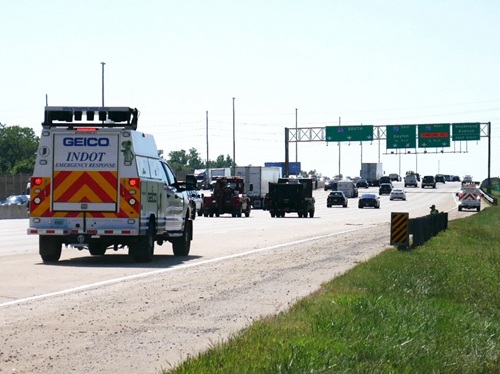Two field studies conducted by the AAA Foundation for Traffic Safety examined the effectiveness of certain “countermeasures” that aim to reduce highway work zone crashes – especially vehicle-mounted electronic variable message signs or VMSs.
[Above photo by the Ohio DOT]
“We examined this safety challenge because these crashes are avoidable if drivers slow down and move over to allow roadside workers the space to carry out their duties safely,” explained Dr. David Yang, president and executive director of the Foundation, in a statement.

According to the Bureau of Labor Statistics, on average, two emergency responders – including tow truck workers – are struck and killed every month by a motorist who fails to obey the law by moving over to an adjacent lane and allowing the roadside rescuers the space to operate.
Yang noted that roadside crashes are notably deadly for tow truck workers, as federal government data shows that tow operators are killed at a rate of almost 43 deaths per 100,000 workers, compared to just three for all other industries.
The Foundation also surveyed tow truck workers, emergency responders, and road maintenance workers as part its two field studies on their experiences with roadside jobs. Of those surveyed, 60 percent had experienced a near miss while working at the roadside, while 15 percent had survived being hit by a passing vehicle.
“We must help drivers see and react appropriately whenever an emergency responder is on the side of the road,” Yang stressed.

The Foundation’s field work found those vehicle-mounted electronic VMSs proved “very effective” in preventing highway work zone crashes.
With VMS activated, drivers changed lanes and slowed down more than when the VMS was not operating – with the odds of a vehicle “moving over” 95 percent higher with VMSs in use.
The Foundation noted that passenger vehicles were more responsive to VMSs than trucks or buses, although both were more likely to move over when VMS was active than when not.
Other countermeasures also have their merits, according to the Foundation’s research, as cones, flares, and emergency flashing light patterns led to “significant lane shifts” by drivers, though they proved less effective at reducing speeds or increasing the distance to the passing vehicles that did not change lanes.
The results from the field studies suggest that using VMS, nighttime light patterns, cones, or flares can positively impact the behaviors of passing motorists under most circumstances.
“AAA is using this research to promote the adoption of lifesaving countermeasures to protect tow [truck] workers and first responders,” noted Cliff Ruud, AAA’s managing director of automotive solutions. “At the same time, AAA will continue educating drivers about the need to obey move-over laws because doing so saves lives.”
 Nation
Nation


